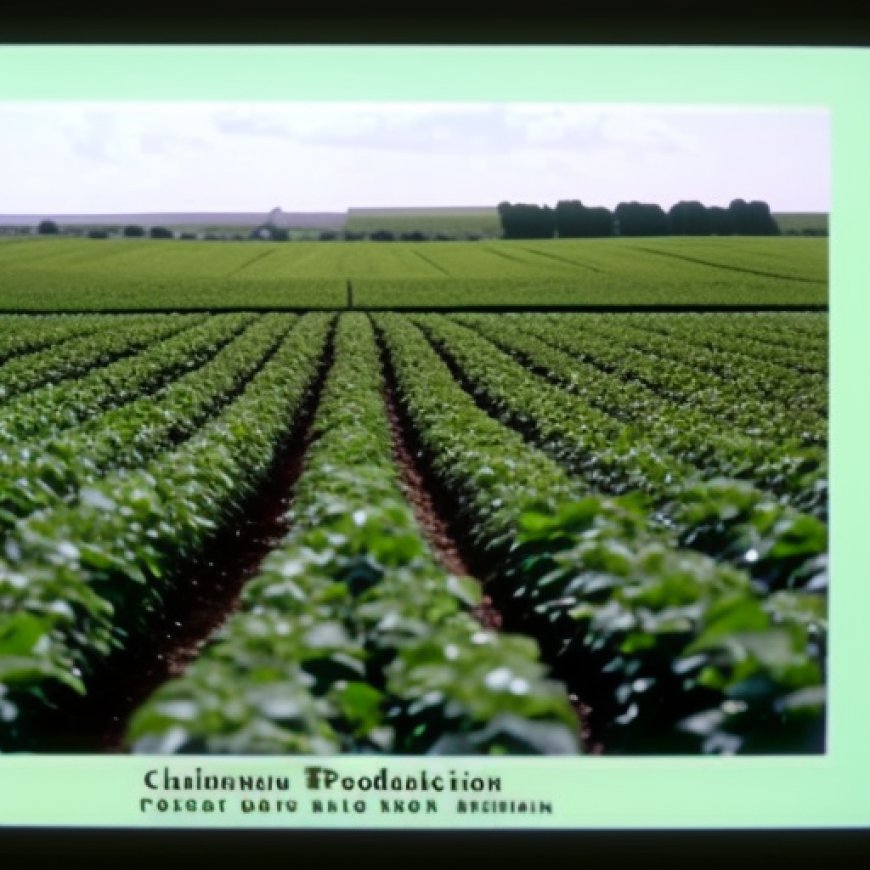Principles of Soil Health: Sustaining profitable agricultural production
Principles of Soil Health: Sustaining profitable agricultural production Open Access Government


The inclusion of a specific reference to soil health in national and state soil action plans addresses the need for the preservation of soil as an essential resource for agricultural production and for the provision of critical ecosystem services
The United Nations highlighted a significant global focus on ‘soil’ with the proclamation of the International Year of Soil in 2015, and the annual celebration of World Soil Day on 6th December.
Examples of these soil action plans are:
This article addresses a number of underlying principles of soil health and corresponding agricultural management practices that support soil health.
Agronomic ‘principles’ vs ‘practices’
Conversations about agricultural principles use a range of concepts and definitions, so there is a need to clarify the terms ‘principles’ and ‘practices’ as they are to be used here. James Sumberg and his colleagues (Sumberg et al. 2023)(1) published an interesting perspective on the evolving meanings of ‘principles’ as applied in agriculture in the journal Outlook on Agriculture. In their open access article, the authors also explored definitions of ‘principle’ in the Oxford English Dictionary which included phases such as “fundamental truth”, “statements about the natural world” and “a general law or rule …as a guide to action”.
Based on their assessment of the range in use of the term ‘principle’ in agronomic contexts, Sumberg et al. clustered agronomic principles used widely into three categories: (i) explanatory, (ii) directive, and (iii) normative and included examples of each. An example of an explanatory principle was “Yield and the quality of products from crops are strongly linked to the supply of nutrients”; an example of a directive principle was “Keep the soil surface covered”; and an example of a normative principle was “An agricultural sector that ensures land use is approporiate given the characteristics of the terrain, maintains soil fertility and health, prevents damage and provides benefits to the surrounding environment, and ensures land acts as a significant greenhouse gas sink.” The sources of these examples are provided in Sumberg et al. (2023) who noted that while there is commonly a close link between ‘principles’ and ‘practices’, they are not the same.
On a global scale, there is increasing interest in soil management practices that build and preserve soil health. The following narrative outlines examples of principles of soil health based on the ‘explanatory’ definition of principle proposed by Sumberg et al. The intention here is to link characteristics of soil which have potential to correspond to ‘healthy’ states of soil for productive and sustainable agriculture to examples of relevant agricultural management practices.
Soil health and soil fertility
Soil fertility has been historically focused on optimising the supply of nutrients for agricultural production. As a result of this production focus, there is a very high level of success in predicting nutrient requirements based on plant type, soil type, topography, environment, climate and history of agricultural management practices. This focus on soil chemical fertility applies to highly mechanised as well as subsistence agricultural systems.
The health of agricultural soils depends on responses of physical, chemical, biological and hydrological soil characteristics to land management practices. Inherent soil properties underpin the manner in which the components of soil health combine to support productive agricultural or natural ecosystems. The origin of the underlying parent rock materials and the extent to which they are weathered, influences naturally occurring nutrient cycling processes in soil. Hence, some soils have inherently high levels of nutrients available for plants, but others have more limited plant-available nutrient resources. Therefore, this background information influences decisions that are made for overcoming plant nutrient limitations using inputs such as manufactured fertilisers or biological amendments such as compost, or for substances such as lime and gypsum that are used to ameliorate non-nutrient soil constraints.
The physical components of soil fertility are closely linked to baseline inherent soil features including the proportions of clay, silt and sand. This may include the type and location of soil carbon, although soil organic matter is also a component of chemical fertility. Soil physical properties influence soil structure, pore size distribution, water-holding capacity, water infiltration, and the adsorption and desorption of nutrients on soil surfaces. Physical properties of soil, especially soil strength and pore structure associated with aggregation of soil particles, also influence root growth.
There is no doubt that soil carbon is a significant pool of the Earth’s carbon resources. The pools of various fractions and forms of carbon in soil cycle at rates which are influenced by how microorganisms and fauna in soil respond to their immediate environment. Therefore, while some components of soil carbon are more recalcitrant or more protected in soil than others, the dynamic of soil carbon pools as a whole is largely dependent on how environmental conditions influence biological processes.
Soil biological properties interface with both soil chemical and soil physical processes and make critical contributions to soil health. This cannot be achieved by focusing only on either nutrient supply (e.g. chemical fertility) or soil structure (e.g. physical fertility). Indeed,
an emphasis on nutrient supply in defining soil fertility for agricultural production has the potential to override important biological processes that contribute to soil health. Such an approach minimises the contributions soil organisms make to soil fertility and limits the development of healthy soil that is resilient to potentially detrimental soil or land management practices and climate change.
Plants make significant contributions to soil health and this often includes interactions with organisms in soil. These interactions trigger mechanisms that alter nutrient access by plants and nutrient cycling from soil organic matter (i.e. factors associated with soil chemical fertility) and includes: (i) the formation of mycorrhizal associations (e.g. contributing to nutrient uptake), (ii) the activities of soil organisms (e.g. contributing to nutrient uptake and decomposition of organic matter in the rhizosphere), (iii) the change in relative abundances of soil organisms (e.g. influencing the rate of nutrient cycling), and (iv) the release of atmospheric nitrogen into soil (e.g. nitrogen from legume residues that include fixed atmospheric nitrogen).
Other interactions between roots and soil organisms can influence soil structure (i.e. factors associated with soil physical fertility). This includes: (i) the formation of mycorrhizal associations (e.g. contributing to access to water under drying soil conditions), (ii) improved soil aggregation (e.g. by increasing the length of hyphae associated with mycorrhizas), and (iii) improved soil penetrability (e.g. due to improved soil pore structure associated with biological stability of soil aggregates which includes roots).
Plant species diversity
SDGs, Targets, and Indicators
SDGs addressed or connected to the issues highlighted in the article:
- SDG 2: Zero Hunger
- SDG 3: Good Health and Well-being
- SDG 6: Clean Water and Sanitation
- SDG 12: Responsible Consumption and Production
- SDG 13: Climate Action
- SDG 15: Life on Land
Specific targets under those SDGs based on the article’s content:
- SDG 2.4: By 2030, ensure sustainable food production systems and implement resilient agricultural practices that increase productivity and production, that help maintain ecosystems, that strengthen capacity for adaptation to climate change, extreme weather, drought, flooding and other disasters, and that progressively improve land and soil quality.
- SDG 3.9: By 2030, substantially reduce the number of deaths and illnesses from hazardous chemicals and air, water and soil pollution and contamination.
- SDG 6.6: By 2020, protect and restore water-related ecosystems, including mountains, forests, wetlands, rivers, aquifers and lakes.
- SDG 12.4: By 2020, achieve the environmentally sound management of chemicals and all wastes throughout their life cycle, in accordance with agreed international frameworks, and significantly reduce their release to air, water and soil in order to minimize their adverse impacts on human health and the environment.
- SDG 13.3: Improve education, awareness-raising and human and institutional capacity on climate change mitigation, adaptation, impact reduction and early warning.
- SDG 15.3: By 2030, combat desertification, restore degraded land and soil, including land affected by desertification, drought and floods, and strive to achieve a land degradation-neutral world.
Indicators mentioned or implied in the article that can be used to measure progress towards the identified targets:
- Indicator 2.4.1: Proportion of agricultural area under productive and sustainable agriculture
- Indicator 3.9.1: Mortality rate attributed to household and ambient air pollution
- Indicator 6.6.1: Change in the extent of water-related ecosystems over time
- Indicator 12.4.1: Number of parties to international multilateral environmental agreements on hazardous waste, hazardous chemicals, and other pollutants
- Indicator 13.3.1: Number of countries that have integrated mitigation, adaptation, impact reduction, and early warning into primary, secondary, and tertiary curricula
- Indicator 15.3.1: Proportion of land that is degraded over total land area
Table: SDGs, Targets, and Indicators
| SDGs | Targets | Indicators |
|---|---|---|
| SDG 2: Zero Hunger | 2.4: By 2030, ensure sustainable food production systems and implement resilient agricultural practices that increase productivity and production, that help maintain ecosystems, that strengthen capacity for adaptation to climate change, extreme weather, drought, flooding and other disasters, and that progressively improve land and soil quality. | Indicator 2.4.1: Proportion of agricultural area under productive and sustainable agriculture |
| SDG 3: Good Health and Well-being | 3.9: By 2030, substantially reduce the number of deaths and illnesses from hazardous chemicals and air, water and soil pollution and contamination. | Indicator 3.9.1: Mortality rate attributed to household and ambient air pollution |
| SDG 6: Clean Water and Sanitation | 6.6: By 2020, protect and restore water-related ecosystems, including mountains, forests, wetlands, rivers, aquifers and lakes. | Indicator 6.6.1: Change in the extent of water-related ecosystems over time |
| SDG 12: Responsible Consumption and Production | 12.4: By 2020, achieve the environmentally sound management of chemicals and all wastes throughout their life cycle, in accordance with agreed international frameworks, and significantly reduce their release to air, water and soil in order to minimize their adverse impacts on human health and the environment. | Indicator 12.4.1: Number of parties to international multilateral environmental agreements on hazardous waste, hazardous chemicals, and other pollutants |
| SDG 13: Climate Action | 13.3: Improve education, awareness-raising and human and institutional capacity on climate change mitigation, adaptation, impact reduction and early warning. | Indicator 13.3.1: Number of countries that have integrated mitigation, adaptation, impact reduction, and early warning into primary, secondary, and tertiary curricula |
| SDG 15: Life on Land | 15.3: By 2030, combat desertification, restore degraded land and soil, including land affected by desertification, drought and floods, and strive to achieve a land degradation-neutral world. | Indicator 15.3.1: Proportion of land that is degraded over total land area |
Behold! This splendid article springs forth from the wellspring of knowledge, shaped by a wondrous proprietary AI technology that delved into a vast ocean of data, illuminating the path towards the Sustainable Development Goals. Remember that all rights are reserved by SDG Investors LLC, empowering us to champion progress together.
Source: openaccessgovernment.org

Join us, as fellow seekers of change, on a transformative journey at https://sdgtalks.ai/welcome, where you can become a member and actively contribute to shaping a brighter future.







